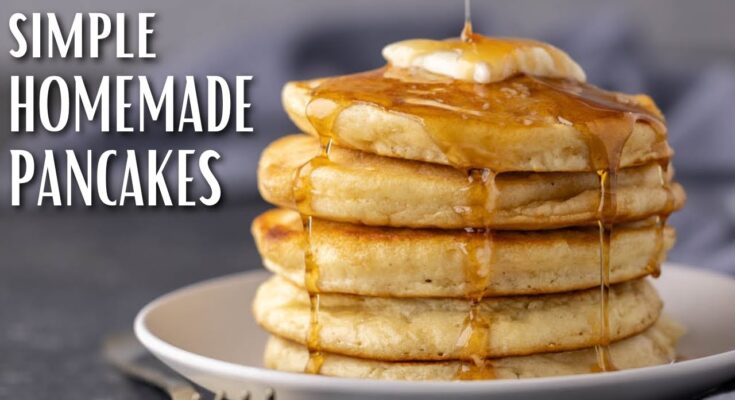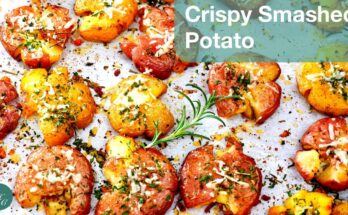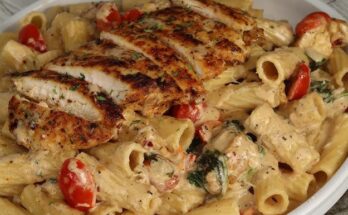Pancake Batter Recipe: Ah, pancakes! They’re the quintessential breakfast dish that can turn any morning into a delightful start to the day. Whether you’re aiming for fluffy, diner-style pancakes or thin, crepe-like delights, it all starts with the batter.
A well-prepared pancake batter is the foundation of a delicious stack. But what makes the perfect pancake batter? Let’s dive into the step-by-step process.
Ingredients You’ll Need
Here’s your basic shopping list to make classic pancakes:
Dry Ingredients:
- 1 ½ cups of all-purpose flour.
- 3 ½ teaspoons of baking powder.
- 1 teaspoon of salt.
- 1 tablespoon of sugar.
Wet Ingredients:
- 1 ¼ cups of milk (dairy or non-dairy).
- 1 egg.
- 3 tablespoons of melted butter or vegetable oil.
Optional Ingredients for Variety:
- Vanilla extract (1 teaspoon for flavor).
- A pinch of cinnamon or nutmeg.
- Add-ins like blueberries, chocolate chips, or chopped nuts.
These ingredients are pantry staples, but feel free to experiment. The key is balancing the wet and dry components to achieve the right texture.
Tools and Equipment Required
Having the right tools on hand can make your pancake preparation a breeze. Here’s what you’ll need:
- A medium-sized mixing bowl for dry ingredients.
- A separate bowl for wet ingredients.
- A whisk or fork for mixing.
- Measuring cups and spoons for accuracy.
- A non-stick pan or griddle for cooking.
- A ladle or measuring cup for pouring batter.
- A spatula for flipping.
Pro Tip: Use a non-stick skillet or griddle to avoid sticking. If you’re serious about pancakes, investing in a flat griddle can make your cooking process smoother.
Preparing the Ingredients
Before mixing, it’s crucial to prep your ingredients properly.
Measuring Dry Ingredients:
- Scoop flour into a measuring cup and level it with a knife for precision.
- Combine flour, baking powder, salt, and sugar in a bowl. Whisk gently to distribute the leavening agent evenly.
Mixing Wet Ingredients:
- Crack the egg into a separate bowl and whisk until frothy.
- Add milk and melted butter, stirring until well combined. If you’re using vanilla or other flavorings, add them here.
Quick Tip: Let your melted butter cool slightly before adding it to avoid cooking the egg prematurely.
Mixing the Pancake Batter
Now comes the fun part: combining the wet and dry ingredients.
- Create a well in the center of the dry ingredients and pour the wet mixture into it.
- Gently fold the ingredients together with a whisk or spatula. Avoid overmixing—small lumps are okay and will dissolve during cooking.
Avoid These Mistakes:
- Don’t beat the batter too hard; it will develop gluten, making the pancakes chewy.
- Ensure no streaks of dry flour remain.
Adjusting Consistency
The consistency of your batter can make or break your pancakes. Aim for a thick, pourable batter. Here’s how to adjust:
- Too Thick: Add a splash of milk and stir gently.
- Too Thin: Sprinkle a small amount of flour into the batter and mix.
A perfect batter should flow slowly off your ladle without being watery.
Resting the Batter
Resting the batter for 5–10 minutes allows the gluten to relax and the baking powder to activate. This step helps create airy, fluffy pancakes. While the batter rests, heat your pan or griddle to medium heat.
Cooking the Pancakes
To cook the pancakes:
- Lightly grease your pan or griddle with butter or oil.
- Use a ladle or measuring cup to pour the batter onto the pan. Keep each pancake around 4–5 inches wide for even cooking.
- Cook on one side until bubbles form on the surface and the edges look set (about 2–3 minutes). Flip carefully with a spatula.
Pro Tip: Maintain a consistent temperature; too hot, and the pancakes will burn on the outside while staying raw inside.
Flipping Techniques
Mastering the flip is easier than you think:
- Wait until bubbles form across the pancake’s surface and the edges appear dry.
- Slide the spatula completely under the pancake, then flip it in one smooth motion.
- Cook the other side for 1–2 minutes until golden brown.
Serving Suggestions
Once your pancakes are perfectly golden and stacked high, it’s time to elevate them with some delicious toppings. Here are some ideas to make your pancakes even more irresistible:
Classic Toppings:
- A drizzle of warm maple syrup.
- A dollop of whipped cream.
- A pat of butter that melts beautifully on top.
Fruity Options:
- Fresh berries like strawberries, blueberries, or raspberries.
- Sliced bananas or caramelized apples.
- A spoonful of fruit preserves or compote.
Decadent Additions:
- Sprinkle powdered sugar for a fancy touch.
- A handful of chocolate chips or cocoa powder dusting.
- Swirls of Nutella or peanut butter.
Savory Twists:
- Crispy bacon or sausage on the side.
- A fried egg for a hearty breakfast stack.
- A sprinkle of shredded cheese for an unconventional delight.
Pair your pancakes with a cup of coffee or a glass of freshly squeezed orange juice for the ultimate breakfast experience.
Variations and Additions
Don’t stop at the classic batter—there’s a whole world of pancake possibilities! Here are some ideas to switch things up:
Flavored Batters:
- Add 2 tablespoons of cocoa powder for chocolate pancakes.
- Mix in a teaspoon of pumpkin spice for a fall-inspired treat.
- Substitute half the milk with buttermilk for extra tanginess.
Fruits and Mix-ins:
- Fold in a handful of blueberries, raspberries, or chopped bananas.
- Add chopped nuts like pecans or almonds for a crunchy texture.
- Mix in shredded coconut or oats for added nutrition.
Savory Pancakes:
- Omit the sugar and add shredded cheese, chopped herbs, or crumbled bacon.
- Serve with sour cream and chives instead of syrup.
Tips for Healthier Pancake Batter
If you want a healthier spin on your pancakes, try these tips:
Flour Alternatives:
- Replace all-purpose flour with whole wheat flour or almond flour.
- Use oat flour for a gluten-free option.
Sugar Substitutes:
- Use honey, maple syrup, or coconut sugar instead of refined sugar.
- Skip the sugar entirely if you’re adding sweet toppings.
Reduce Fat Content:
- Use unsweetened applesauce or mashed bananas in place of butter.
- Substitute regular milk with low-fat or plant-based milk.
Boost Nutrition:
- Add chia seeds, flaxseeds, or protein powder to the batter.
- Incorporate grated zucchini or carrots for hidden veggies.
Storing Leftover Batter
If you have leftover batter, don’t let it go to waste! Follow these tips to store it for future use:
Refrigeration:
- Transfer the batter to an airtight container and refrigerate for up to 2 days.
- Stir before using, as ingredients may separate over time.
Freezing:
- Pour the batter into freezer-safe bags or containers.
- Freeze for up to 1 month. Thaw in the refrigerator overnight before using.
Pro Tip: Alternatively, cook all the pancakes and store them in the fridge or freezer. Reheat them in a toaster or microwave for a quick breakfast.
Common Pancake Batter Issues and Fixes
Sometimes, things don’t go as planned, but don’t worry—here are some solutions to common problems:
Lumpy Batter:
- Solution: Whisk gently but thoroughly to break up lumps without overmixing.
Too Thick Batter:
- Solution: Add a splash of milk and stir until the desired consistency is achieved.
Pancakes Stick to the Pan:
- Solution: Ensure the pan is hot enough and well-greased before pouring the batter.
Flat Pancakes:
- Solution: Check that your baking powder is fresh and properly measured.
Uneven Cooking:
- Solution: Maintain a steady medium heat and avoid overcrowding the pan.
FAQs about Pancake Batter Recipe
1. What ingredients are needed for pancake batter?
The basic ingredients for pancake batter include all-purpose flour, milk, eggs, sugar, baking powder, salt, and melted butter or oil. You can also add vanilla extract or cinnamon for extra flavor.
2. How do I make pancake batter from scratch?
To make pancake batter, mix the dry ingredients (flour, sugar, baking powder, and salt) in one bowl and the wet ingredients (milk, eggs, and melted butter) in another. Combine the two mixtures gently, ensuring there are no lumps, but avoid overmixing to keep the pancakes fluffy.
3. Can I prepare pancake batter in advance?
Yes, you can prepare pancake batter ahead of time and store it in the refrigerator for up to 24 hours. However, if the batter contains baking powder, it’s best to use it within a few hours for optimal fluffiness.
4. How do I adjust pancake batter for thinner or thicker pancakes?
To make thinner pancakes, add a little more milk to the batter. For thicker pancakes, reduce the milk slightly or add more flour in small increments until the desired consistency is achieved.
5. Can pancake batter be frozen?
Yes, pancake batter can be frozen for up to a month. Pour the batter into a freezer-safe container, leaving room for expansion. Thaw it in the refrigerator overnight before using.
Conclusion
Making the perfect pancake batter isn’t rocket science, but it does require a little attention to detail. From selecting the best ingredients to mastering the art of flipping, each step plays a crucial role in creating those fluffy, golden pancakes we all love. Whether you’re sticking to the classic recipe or experimenting with fun variations, there’s no limit to how creative you can get. So, grab your apron, fire up the griddle, and enjoy the delicious fruits of your labor!



